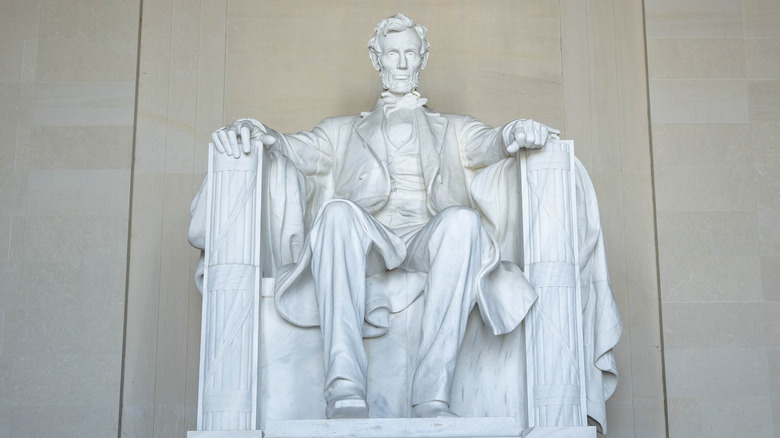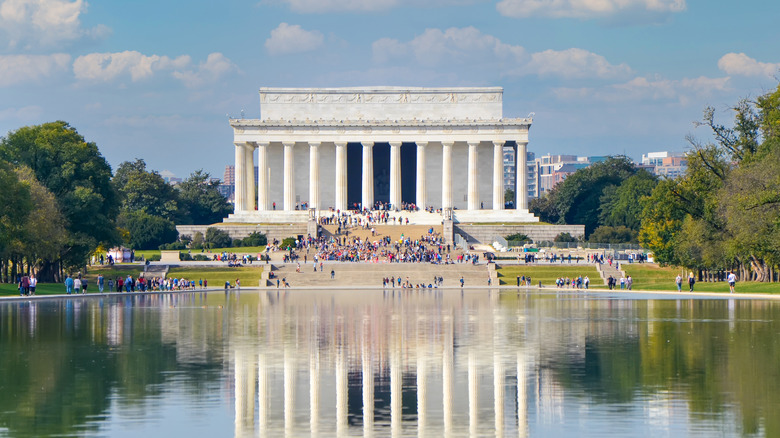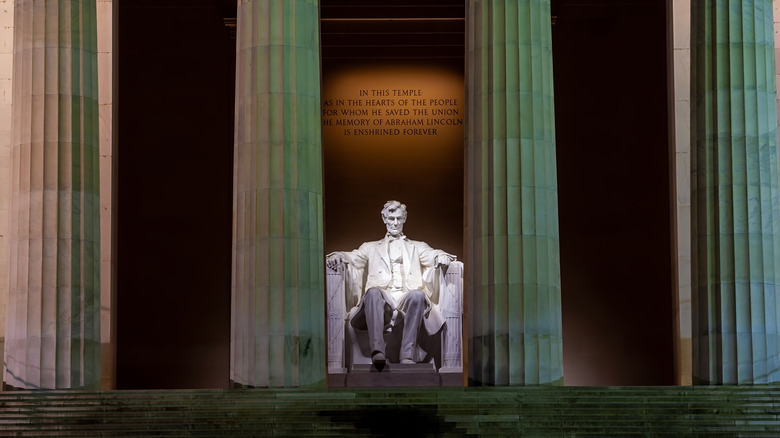The Truth About The Underground Chamber In The Lincoln Memorial
The Lincoln Memorial, with its statue of storied 14th President Abraham Lincoln in a marble atrium, is one of the most well-known symbols of America. However, what is less known is that below it, there's a pavilion measuring a whopping 43,800 square feet, standing three stories tall (via Atlas Obscura).
While the knowledge of a secret cavern beneath the Lincoln Memorial sounds like something out of the movie "National Treasure," the reason for its construction is much more practical. The location of the Lincoln Memorial sits on the Potomac River, which has marshy shores that create a less than desirable foundation. According to History, workers on the original structure, built 1914 and 1922, had to dig as deep as 65 feet underground and install 122 concrete columns to connect the memorial to the earth's bedrock to compensate for the swampy structural base. In fact, the task was so monumental, and the resulting space was so large, that it was even given its own name: the Undercroft.
Despite the fact that the Lincoln Memorial is one of the most trafficked national parks in the country (via AZCentral), the underground cavern remained unused until the building was the focus of a restoration project in 1975 — and what was built underneath was almost unbelievable.
Entering the forgotten basement
In 1975, a move to build new bathrooms at the memorial had construction crews stumbling into the floors below, and they found what looked like a hidden world (via Atlas Obscura). According to Hachette Book Group, hundreds of stalactites had developed since it was built — the result of water slowly dripping through the floor of the marble space.
The cavern was so closed off that it had even developed its own ecosystem and was classified as a cave, per Atlas Obscura. However, while the stalactites and the ecosystem below showcased how time had passed in the forgotten foundation, there were other aspects of the space that served as a reminder that the memorial it was built in the 1910s and 1920s. This included graffiti that workers had scribbled on the concrete pillars.
Some of the pillars, in fact, were marked with cartoons drawn by the builders, according to Architect of the Capital. The graffiti has since been covered with plexiglass to protect it as a piece of the monument's history.
Some of the drawings included sketches of characters from the first newspaper comic strip ever, known as "Mutt and Jeff" (via Hachette Book Group).
The future of the undercroft
Following the re-discovery of the Undercroft in 1970s, the National Parks started providing tours so that the public could see the underground basement for themselves. These tours continued throughout the 1980s, but they were discontinued in 1989 following the discovery of asbestos, per Atlas Obscura.
After three decades of additional neglect, the Undercroft will open to the public once more. In honor of the monument's centennial, May 30, 2022, the National Park Service plans to re-open tours of the space, though a date has not yet been announced (via The Lincoln Group). In 2016, philanthropist David Rubenstein offered $18 million to renovate the monument, including the Undercroft. To ensure everything was done safely and properly, a large number of high-tech scans were taken in the days preceding the start of construction, according to NBC Philadelphia, in addition to high-resolution photos were taken to fill in any information gaps.
History fans and D.C. residents alike can plan to take the flashlight tours that will soon show what lies underneath honest Abe.


